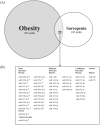MicroRNAs in obesity, sarcopenia, and commonalities for sarcopenic obesity: a systematic review
- PMID: 34984856
- PMCID: PMC8818592
- DOI: 10.1002/jcsm.12878
MicroRNAs in obesity, sarcopenia, and commonalities for sarcopenic obesity: a systematic review
Abstract
Sarcopenic obesity is a distinct condition of sarcopenia in the context of obesity, with the cumulative health risks of both phenotypes. Differential expression of microRNAs (miRNAs) has been reported separately in people with obesity and sarcopenia and may play a role in the pathogenesis of sarcopenic obesity. However, this has not been explored to date. This study aimed to identify differentially expressed miRNAs reported in serum, plasma, and skeletal muscle of people with obesity and sarcopenia and whether there are any commonalities between these conditions. We performed a systematic review on Embase and MEDLINE (PROSPERO, CRD42020224486) for differentially expressed miRNAs (fold change >1.5 or P-value <0.05) in (i) sarcopenia or frailty and (ii) obesity or metabolic syndrome. The functions and targets of miRNAs commonly changed in both conditions, in the same direction, were searched using PubMed. Following deduplication, 247 obesity and 42 sarcopenia studies were identified for full-text screening. Screening identified 36 obesity and 6 sarcopenia studies for final inclusion. A total of 351 miRNAs were identified in obesity and 157 in sarcopenia. Fifty-five miRNAs were identified in both obesity and sarcopenia-by sample type, 48 were found in plasma and one each in serum and skeletal muscle. Twenty-four miRNAs were identified from 10 of the included studies as commonly changed in the same direction (22 in plasma and one each in serum and skeletal muscle) in obesity and sarcopenia. The majority of miRNA-validated targets identified in the literature search were members of the phosphoinositide 3-kinase/protein kinase B and transforming growth factor-β signalling pathways. The most common targets identified were insulin-like growth factor 1 (miR-424-5p, miR-483-3p, and miR-18b-5p) and members of the SMAD family (miR-483-3p, miR-92a-3p, and miR-424-5p). The majority of commonly changed miRNAs were involved in protein homeostasis, mitochondrial dynamics, determination of muscle fibre type, insulin resistance, and adipogenesis. Twenty-four miRNAs were identified as commonly dysregulated in obesity and sarcopenia with functions and targets implicated in the pathogenesis of sarcopenic obesity. Given the adverse health outcomes associated with sarcopenic obesity, understanding the pathogenesis underlying this phenotype has the potential to lead to effective screening, monitoring, or treatment strategies. Further research is now required to confirm whether these miRNAs are differentially expressed in older adults with sarcopenic obesity.
Keywords: Frailty; Metabolic syndrome; MicroRNA; Obesity; Sarcopenia.
© 2021 The Authors. Journal of Cachexia, Sarcopenia and Muscle published by John Wiley & Sons Ltd on behalf of Society on Sarcopenia, Cachexia and Wasting Disorders.
Conflict of interest statement
None declared.
Figures


Similar articles
-
Circulating miR-144-3p as a Novel Independent Biomarker Associated With Low Muscle Strength Among Older Adults.J Cachexia Sarcopenia Muscle. 2025 Aug;16(4):e70026. doi: 10.1002/jcsm.70026. J Cachexia Sarcopenia Muscle. 2025. PMID: 40726320 Free PMC article.
-
MicroRNAs as commonly expressed biomarkers for sarcopenia and frailty: A systematic review.Exp Gerontol. 2024 Nov;197:112600. doi: 10.1016/j.exger.2024.112600. Epub 2024 Oct 3. Exp Gerontol. 2024. PMID: 39349187
-
The effect of Tai Chi in elderly individuals with sarcopenia and frailty: A systematic review and meta-analysis of randomized controlled trials.Ageing Res Rev. 2022 Dec;82:101747. doi: 10.1016/j.arr.2022.101747. Epub 2022 Oct 9. Ageing Res Rev. 2022. PMID: 36223875
-
A rapid and systematic review of the clinical effectiveness and cost-effectiveness of topotecan for ovarian cancer.Health Technol Assess. 2001;5(28):1-110. doi: 10.3310/hta5280. Health Technol Assess. 2001. PMID: 11701100
-
Signs and symptoms to determine if a patient presenting in primary care or hospital outpatient settings has COVID-19.Cochrane Database Syst Rev. 2022 May 20;5(5):CD013665. doi: 10.1002/14651858.CD013665.pub3. Cochrane Database Syst Rev. 2022. PMID: 35593186 Free PMC article.
Cited by
-
Potential protective effects of increased serum uric acid concentration in sarcopenia: A meta-analysis and systematic review.Medicine (Baltimore). 2024 Mar 1;103(9):e37376. doi: 10.1097/MD.0000000000037376. Medicine (Baltimore). 2024. PMID: 38428844 Free PMC article.
-
Understanding the development of sarcopenic obesity.Expert Rev Endocrinol Metab. 2023 Sep-Nov;18(6):469-488. doi: 10.1080/17446651.2023.2267672. Epub 2023 Nov 28. Expert Rev Endocrinol Metab. 2023. PMID: 37840295 Free PMC article. Review.
-
Induction of miR-665-3p Impairs the Differentiation of Myogenic Progenitor Cells by Regulating the TWF1-YAP1 Axis.Cells. 2023 Apr 8;12(8):1114. doi: 10.3390/cells12081114. Cells. 2023. PMID: 37190023 Free PMC article.
-
Sarcopenia and cachexia: molecular mechanisms and therapeutic interventions.MedComm (2020). 2025 Jan 5;6(1):e70030. doi: 10.1002/mco2.70030. eCollection 2025 Jan. MedComm (2020). 2025. PMID: 39764565 Free PMC article. Review.
-
Extracellular MicroRNAs as Potential Biomarkers for Frail Kidney Phenotype: Progresses and Precautions.Aging Dis. 2024 Aug 1;15(4):1474-1481. doi: 10.14336/AD.2023.0818. Aging Dis. 2024. PMID: 37611904 Free PMC article.
References
-
- Bhasin S, Travison TG, Manini TM, Patel S, Pencina KM, Fielding RA, et al. Sarcopenia definition: the position statements of the Sarcopenia Definition and Outcomes Consortium. J Am Geriatr Soc 2020;68:1410–1418. - PubMed
-
- Donini LM, Busetto L, Bauer JM, Bischoff S, Boirie Y, Cederholm T, et al. Critical appraisal of definitions and diagnostic criteria for sarcopenic obesity based on a systematic review. Clin Nutr 2020;39:2368–2388. - PubMed
-
- Roubenoff R. Sarcopenic obesity: the confluence of two epidemics. Obes Res 2004;12:887–888. - PubMed

